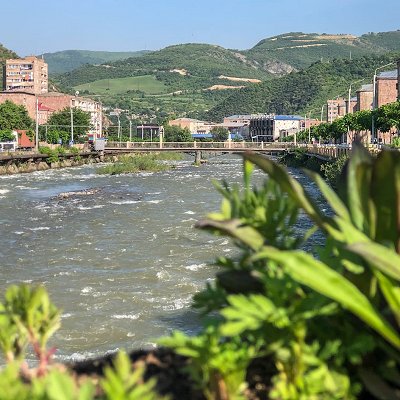
Like us on Facebook
PLACE NAMES



|
| Kapan |
 |
|
Kapan is a town in southeast Armenia, serving as the administrative centre of the Kapan Municipality and also as the provincial capital of Syunik Province. It is located in the valley of the Voghji River and is on the northern slopes of Mount Khustup. Kapan is the most populous town in the Syunik Province as well as the entire region of southern Armenia. According to the 2011 census, the population of Kapan was 43,190, a slight decline from 45,711 in the 2001 census. According to the 2023 official estimate, the current population of the town is around 41,300.
The name Kapan derives from the Classical Armenian common noun meaning 'mountain pass' In later centuries, the name evolved into Ghap'an, which was in use until 1991, when the older form of the name was restored.
The area of modern-day Kapan was first mentioned in the 5th century as a small settlement within the properties of the Siunia dynasty. Historically, it was part of the Baghk’ canton of Syunik, the ninth province of the historic Greater Armenia. Though originally a small settlement, by the late 9th and early 10th century, it was fortified by Prince Dzagik, becoming the residence of the Dzagikian princes. By the end of the 10th century, the ruler of Syunik, Prince Smbat II, moved to the town of Kapan and founded the Kingdom of Syunik, proclaiming himself a king under the protectorate of the Bagratid Kingdom of Armenia. As the capital of the Kingdom of Syunik, Kapan flourished throughout the 11th century, reaching around 20 thousand inhabitants, composed of mostly Armenians with a prominent Jewish minority, and being a center of trades, crafts, and metallurgy.
In 1103, Kapan was entirely ruined by the Seljuk invaders. The medieval Armenian historian Stephen Orbelian of Syunik states that the Seljuks began massacring from the Jewish quarter of Kapan. After the fall of the Kingdom of Syunik in 1170, Syunik and the rest of the historic territories of Armenia suffered from the Seljuk, Mongol, Aq Qoyunlu and Kara Koyunlu invasions, in that order, between the 12th and 15th centuries.
At the beginning of the 16th century, Kapan became part of the Erivan Province within the Safavid Iran. In 1722, the Armenian principality of Kapan was established by uniting the noble families of Syunik into one state in order to fight against Muslim oppression. By the beginning of the 18th century, Kapan was associated with the Armenian military leader David Bek, who led the liberation campaign of the Armenians of Syunik against the Iranians and the invading Ottoman Turks. David Bek started his battles in 1722 with the help of thousands of local Armenians, including Avan Yuzbashi and Mkhitar Sparapet, taking control of Syunik. The centre of Bek's struggle was the Baghaberd Fortress northwest of Kapan and the Halidzor Fortress southwest of Kapan, where he died in 1728. In 1747, Kapan was incorporated into the Nakhichevan Khanate and by 1750, Kapan became part of the newly formed Karabakh Khanate. It was turned into a significant urban settlement during Qajar Iranian rule by the end of the 18th century.[citation needed]
In 1813, the territory of historic Syunik, including the region of Kapan, officially became part of the Russian Empire as a result of the Russo-Persian War of 1804–13 and the following Treaty of Gulistan signed between Russia and Iran. In 1828–30, many Armenian families from the Iranian cities of Khoy and Salmast migrated to the region. In 1868, it became part of the Zangezur uezd within the Elizavetpol Governorate of the Russian Empire. By the last quarter of the 19th century, Kapan formed an important urban community for the region as a result of merging several villages together.
Both the Republic of Armenia and the Azerbaijan Democratic Republic claimed Kapan between 1918 and 1920. As a result of the sovietisation of Armenia in December 1920, Kapan was included in the Republic of Mountainous Armenia under the commandment of Garegin Nzhdeh, who fought against the Bolsheviks between 26 April and 12 July 1921. After the Soviet Red Army entered the Zangezur region in July 1921, Kapan, along with the towns of Goris, Sisian and Meghri, fell under the Soviet rule, where it was administered as part of the Armenian SSR.
In September 1930, the Kafan raion was formed with Kapan as its administrative center. In 1938, Kapan received city status.[8] Until 1991, the city was called Kafan in Russian and Ghap'an in Armenian.
Following the independence of Armenia in 1991, Kapan became the centre of the newly formed Syunik Province as per the 1995 administrative reforms of the republic. Many streets bearing the name of Bolshevik activists were changed. The town's central square was renamed after Garegin Nzhdeh, while the central park of the town was named after Vazgen Sargsyan.
During the First Nagorno-Karabakh War, Kapan was bombarded by artillery coming from the neighboring Zangilan District of Azerbaijan, causing deaths among the civilian population. This prompted an Armenian operation to capture several nearby Azerbaijani border villages in December 1992.
|
 Feel free to Email me any additions or corrections Feel free to Email me any additions or corrections
LINKS AVAILABLE TO YOUR SITE
| |





